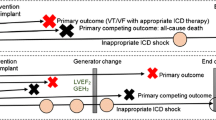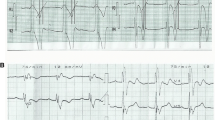Abstract
Objectives
This study aims to determine whether fragmented QRS (fQRS) in the surface electrocardiogram (ECG) at implantable cardioverter defibrillator (ICD) implant can predict arrhythmic events using appropriate therapy delivered by the ICD as a surrogate.
Background
Hypertrophic obstructive cardiomyopathy (HOCM) is a genetic disorder associated with life-threatening arrhythmias frequently requiring an ICD. Seeking a noninvasive method of risk stratification remains a challenge.
Methods
This paper is a retrospective, multicenter study of patients with HOCM and ICD. Surface 12-lead ECGs were analyzed. Appropriate therapy was validated by a blinded Core Lab. Univariate and multivariate analyses were performed. A p value of <0.05 was considered significant.
Results
We included 102 patients from 13 centers. Mean age at implant was 41.16 ± 18.25 years, 52 % were male. Mean left ventricular ejection fraction was 61.56 ± 9.46 % and two thirds had heart failure according to the New York Heart Association class I. Secondary prophylaxis ICD implantation was the indication for implant in 40.2 % of cases. About half received a single-chamber ICD. fQRS was present at the time of diagnosis in 21 and in 54 % at ICD implant. At a mean follow-up of 47.8 ± 39.3 months, 41 patients (40.2 %) presented with appropriate therapy. In a multivariate logistic regression, predictors of appropriate therapy included fQRS at implant (odds ratio [OR], 16.4; 95 % confidence interval [CI], 3.6–74.0; p = 0.0003), history of combined ventricular tachycardia/fibrillation/sudden death (OR, 14.3; 95 % CI, 3.2–69.3; p = 0.001) and history of syncope (OR, 5.5; 95 % CI, 1.5–20.4; p = 0.009). Ten deaths (9.8 %) occurred during the follow-up. fQRS in the lateral location increased the risk of appropriate therapy (p < 0.0001).
Conclusions
fQRS predicts arrhythmic events in patients with HOCM and should be considered in a model of risk stratification.

Similar content being viewed by others
Abbreviations
- CAD:
-
Coronary artery disease
- ECG:
-
12-Lead electrocardiogram
- fQRS:
-
Fragmented QRS
- HOCM:
-
Hypertrophic obstructive cardiomyopathy
- ICD:
-
Implantable cardioverter defibrillator
- SCD:
-
Sudden cardiac death
- VF:
-
Ventricular fibrillation
- VT:
-
Ventricular tachycardia
References
Maron, B. J. (2004). Hypertrophic cardiomyopathy: an important global disease. American Journal of Medicine, 116, 63–5.
Maron, B. J., Gardin, J. M., Flack, J. M., et al. (1995). Prevalence of hypertrophic cardiomyopathy in a general population of young adults: echocardiographic analysis of 4111 subjects in the CARDIA Study Coronary Artery Risk Development in (Young) Adults. Circulation, 92, 785–9.
Teare, D. (1958). Asymmetrical hypertrophy of the heart in young adults. British Heart Journal, 20, 1–8.
Elliott, P. M., Poloniecki, J., Dickie, S., et al. (2000). Sudden death in hypertrophic cardiomyopathy: identification of high risk patients. Journal of the American College of Cardiology, 36, 2212–8.
Christiaans, I., Van Engelen, K., Van Langen, I. M., et al. (2010). Risk stratification for sudden cardiac death in hypertrophic cardiomyopathy: systematic review of clinical risk markers. Europace, 12, 313–21.
Maron, B. J. (2002). Hypertrophic cardiomyopathy: a systematic review. JAMA: The Journal of the American Medical Association, 287, 1308–20.
Wigle, E. D., Rakowski, H., Kimball, B. P., et al. (1995). Hypertrophic cardiomyopathy: clinical spectrum and treatment. Circulation, 92, 1680–92.
Efthimiadis, G. K., Parcharidou, D. G., Giannakoulas, G., et al. (2009). Left ventricular outflow tract obstruction as a risk factor for sudden cardiac death in hypertrophic cardiomyopathy. The American Journal of Cardiology, 104, 695–9.
Gersh, B. J., Maron, B. J., Bonow, R. O., American College of Cardiology Foundation/American Heart Association Task Force on Practice Guidelines, et al. (2011). ACCF/AHA guideline for the diagnosis and treatment of hypertrophic cardiomyopathy: a report of the American College of Cardiology Foundation/American Heart Association Task Force on Practice Guidelines. Developed in collaboration with the American Association for Thoracic Surgery, American Society of Echocardiography, American Society of Nuclear Cardiology, Heart Failure Society of America, Heart Rhythm Society, Society for Cardiovascular Angiography and Interventions, and Society of Thoracic Surgeons. Journal of the American College of Cardiology, 58, e212–60.
Das, M. K., Khan, B., Jacob, S., Kumar, A., & Mahenthiran, J. (2006). Significance of a fragmented QRS complex versus a Q wave in patients with coronary artery disease. Circulation, 113, 2495–2501.
Das, M. K., Suradi, H., Maskoun, W., et al. (2008). Fragmented wide QRS on a 12-lead ECG: a sign of myocardial scar and poor prognosis. Circulation. Arrhythmia and Electrophysiology, 1, 258–268.
Femenia, F., Arce, M., Arrieta, M., & Baranchuk, A. (2012). Surface fragmented QRS in a patient with hypertrophic cardiomyopathy and malignant arrhythmias: is there an association? Journal of Cardiovascular Disease Research, 3, 32–5.
Sakane, K., Takaki, H., Okamura, H., et al. (2011). Visualization of intra-QRS fragmented activation in patients with hypertrophic cardiomyopathy and life-threatening ventricular arrhythmia using magnetocardiography. European Heart Journal, 32(Suppl. 1), 155.
Sha, J., Zhang, S., Tang, M., Chen, K., Zhao, X., & Wang, F. (2011). Fragmented QRS is associated with all-cause mortality and ventricular arrhythmias in patients with idiopathic dilated cardiomyopathy. Annals of Noninvasive Electrocardiology, 16, 270–5.
Basaran, Y., Tigen, K., Karaahmet, T., et al. (2011). Fragmented QRS complexes are associated with cardiac fibrosis and significant intraventricular systolic dyssynchrony in nonischemic dilated cardiomyopathy patients with a narrow QRS interval. Echocardiography, 28, 62–8.
Rodriguez, C., Baranchuk, A., Femenia, F., et al. (2011). Fragmented ECG in Chagas’ cardiomyopathy (FECHA Study). PACE, 34, P109.
Baranchuk, A., Miranda, R., Femenía, F., & FECHA Investigators. (2012). Chagas cardiomyopathy and fragmented QRS. Re: QRS fragmentation as a marker of arrhythmias in coronary artery disease, in cardiomyopathies and ion cannel diseases. International Journal of Cardiology, 160, 151–2.
Peters, S., Trümmel, M., & Koehler, B. (2008). QRS fragmentation in standard ECG as a diagnostic marker of arrhythmogenic right ventricular dysplasia cardiomyopathy. Heart Rhythm, 5, 1417–21.
Peters, S., Trümmel, M., & Koehler, B. (2012). Prognostic value of QRS fragmentation in patients with arrhythmogenic right ventricular cardiomyopathy/dysplasia. Journal of Cardiovascular Medicine, 13, 295–8.
Priori, S. G., Gasparini, M., Napolitano, C., et al. (2012). Risk stratification in Brugada syndrome: results of the PRELUDE (PRogrammed ELectrial stimUlation preDictive valuE) registry. Journal of the American College of Cardiology, 59, 37–45.
Haraoka, K., Morita, H., Saito, Y., et al. (2010). Fragmented QRS is associated with torsades de pointes in patients with acquired long QT syndrome. Heart Rhythm, 7, 1808–14.
Das, M. K., Michael, M. A., Suradi, H., et al. (2009). Usefulness of fragmented QRS on a 12-lead electrocardiogram in acute coronary syndrome for predicting mortality. The American Journal of Cardiology, 104, 1631–1637.
Das, M. K., & Zipes, D. P. (2009). Fragmented QRS: a predictor of mortality and sudden cardiac death. Heart Rhythm, 6, S8–14.
Das, M. K., Saha, C., El Masry, H., et al. (2007). Fragmented QRS on a 12-lead ECG: a predictor of mortality and cardiac events in patients with coronary artery disease. Heart Rhythm, 4, 1385–1392.
Wiener, I., Mindich, B., & Pitchon, R. (1984). Fragmented endocardial electrical activity in patients with ventricular tachycardia: a new guide to surgical therapy. American Heart Journal, 107, 86–90.
de Bakker, J. M., van Capelle, F. J., Janse, M. J., et al. (1996). Fractionated electrograms in dilated cardiomyopathy: origin and relation to abnormal conduction. Journal of the American College of Cardiology, 27, 1071–1078.
Author information
Authors and Affiliations
Consortia
Corresponding author
Additional information
The FHOCM Study participating investigators and centers include: Francisco Femenía, Mauricio Arce, Jorge Van Grieken, Martín Arrieta, Hospital Español de Mendoza, Argentina; Adrian Baranchuk, Wilma Hopman, Heart Rhythm Service, Queen’s University, Kingston, Ontario, Canada; Luis Mont Girbau, Emilce Trucco, Servicio de Arritmias, Hospital Clinic, Barcelona, España; Carlos Rodriguez Artuza, IECTAS, Zulía, Venezuela; Alfredo Bravo, Claudio Fessia, Instituto Cardiovascular, Villa Mercedes, San Luis, Argentina; Mauricio Abello, FLENI, Buenos Aires, Argentina; Bulent Gorenek, Eskisehir Osmangazi University, Turkey; Máximo Rivero-Ayerza, Bruselas, Bélgica; José Luis Merino, Jorge Figueroa, Hospital La Paz, Madrid, España.
Rights and permissions
About this article
Cite this article
Femenía, F., Arce, M., Van Grieken, J. et al. Fragmented QRS as a predictor of arrhythmic events in patients with hypertrophic obstructive cardiomyopathy. J Interv Card Electrophysiol 38, 159–165 (2013). https://doi.org/10.1007/s10840-013-9829-z
Received:
Accepted:
Published:
Issue Date:
DOI: https://doi.org/10.1007/s10840-013-9829-z




